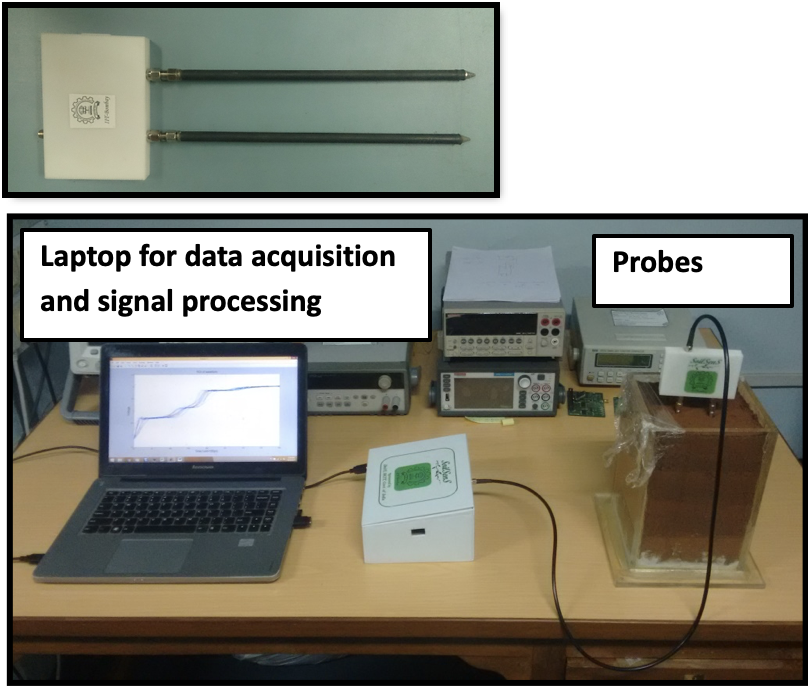Apparatus and method for measuring moisture content in medium using Time Domain Reflectometry (TDR)
This technology describes a novel apparatus and method for measuring moisture content in various mediums (e.g., soil) using Time Domain Reflectometry (TDR). The system utilizes a pulse generator to transmit a waveform along a cable connected to a TDR probe inserted into the medium. A sampler captures the waveform reflected from specific points on the probe, which correspond to impedance mismatches. The signal is processed, and the moisture content is calculated based on the waveform’s travel time between the identified points. This approach enables accurate and cost-effective moisture content measurement in agriculture, environmental monitoring, and construction.
Traditional methods for measuring moisture content in media often suffer from limitations such as high cost, complexity, and insufficient accuracy. These conventional systems may also require significant memory resources and have slower response times, making them less efficient for real-time applications. Commercial TDR systems used for this purpose have reported accuracy ranging from 0 to 3%, which may need to be revised for specific applications. There is a need for a cost-effective and accurate apparatus and method for measuring moisture content in various mediums, including soil, using TDR technology.
- Based on Time Domain Reflectometry: Utilizes Time Domain Reflectometry (TDR) with a novel sampling and signal reconstruction technique to provide precise moisture content readings in various media (soil, glass, sand, water, etc.)
- Reduced memory requirement: Employs a 1-bit Adaptive Delta Modulator (ADM) for sampling, significantly reducing memory storage needs.
- High-resolution sampling: Achieves picosecond resolution in sampling the reflected waveform, enabling accurate measurement of even very short travel times.
- Adaptive step size for improved signal reconstruction: The ADM dynamically adjusts the step size based on the slope of the signal for efficient sampling.
- Independent and precise pulse generation: The pulse generator utilizes a crystal oscillator for high-frequency precision and stability,
- Impedance matching for signal integrity: Implements a Current Feedback Amplifier (CFA) to match the impedance of the pulse generator to the transmission line, minimizing signal reflections and maintaining signal integrity.
- Flexible TDR probe design: Allows TDR probes with two or three rods, offering flexibility in electric field distribution and application-specific customization.
The moisture content measuring device consists of a pulse generator, a TDR probe, a sampler, and a signal processing unit. The pulse generator, employing a Pierce oscillator, Schmitt trigger, fast comparator, and a Current Feedback Amplifier (CFA), produces periodic pulses with a rise time of 2ns. These pulses, transmitted as a waveform through a 50Ω coaxial cable, travel along the TDR probe inserted into the medium. An equivalent time sampling technique, using a Direct Digital Synthesizer (DDS) and an Adaptive Delta Modulator (ADM), samples the reflected waveform with a 100ps resolution. The signal processing unit reconstructs the sampled waveform and calculates the moisture content by analyzing the waveform’s travel time, which is determined from the time difference between reflections at the probe head and the open end.
The technology could significantly impact fields such as agriculture and environmental monitoring. For instance, by accurately determining soil moisture, farmers can optimize irrigation schedules, reducing water wastage and improving crop yield. This directly addresses the challenge of sustainable water resource management in agriculture. The low cost and efficient design of the apparatus make it accessible for wider adoption, potentially benefiting both developed and developing economies.
The technology focuses on precise moisture content measurement in various media like soil, glass, sand, and water. Its primary application lies in agriculture, particularly for irrigation monitoring and control, optimizing crop yields, and managing water resources. In environmental monitoring, it can aid in analyzing soil moisture profiles, studying water movement in ecosystems, and contributing to flood control measures.

